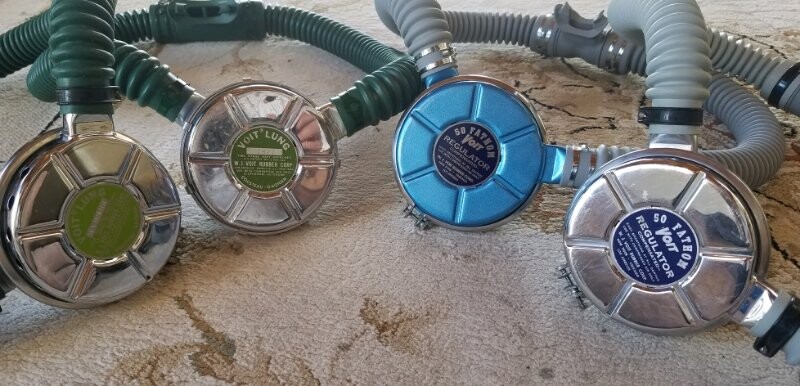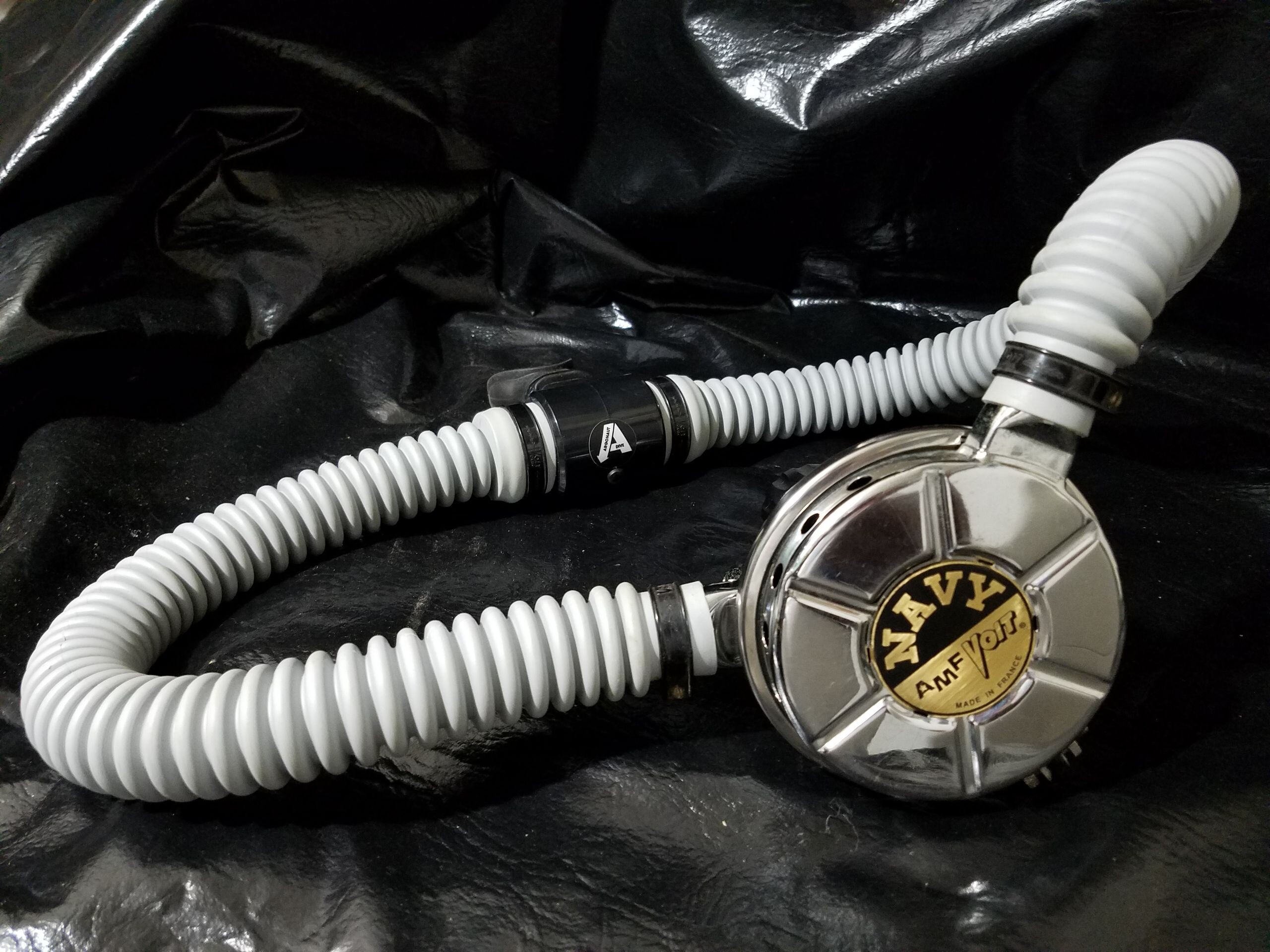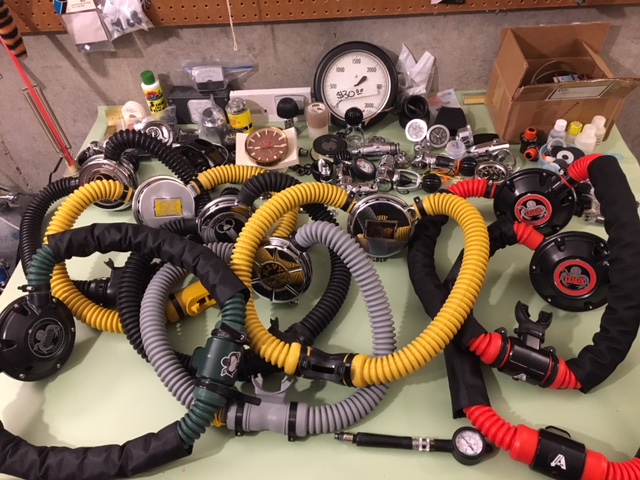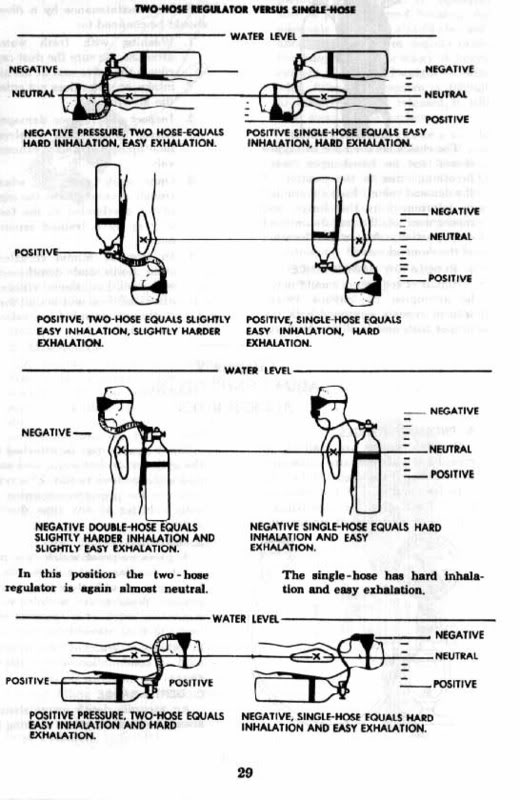I'm allowed one dumb question a day so here it is. Why MUST the second stage (demand valve) be positioned in front of your mouth? Simple hydraulics would suggest that there is no reason it could not be placed elsewhere in the "circuit", e.g. coupled to the first stage. The resultant low pressure line routed from there to the diver's mouth then looks little more than a flexible snorkel. The diver places the demand on the "snorkel" (i.e. draws breath) and the demand is hydraulically (pneumatically?) transmitted to the "real" demand valve situated behind his head close by the first stage. The physics of it all remains unchanged, but the diver no longer has a bulky weight hanging out of his mouth. He / she feels the same effort to pull and exhale. Or am I missing something?
You are using an out of date browser. It may not display this or other websites correctly.
You should upgrade or use an alternative browser.
You should upgrade or use an alternative browser.
Second stage placement
- Thread starter alanb3006
- Start date
Please register or login
Welcome to ScubaBoard, the world's largest scuba diving community. Registration is not required to read the forums, but we encourage you to join. Joining has its benefits and enables you to participate in the discussions.
Benefits of registering include
- Ability to post and comment on topics and discussions.
- A Free photo gallery to share your dive photos with the world.
- You can make this box go away
You mean something like this?I'm allowed one dumb question a day so here it is. Why MUST the second stage (demand valve) be positioned in front of your mouth? Simple hydraulics would suggest that there is no reason it could not be placed elsewhere in the "circuit", e.g. coupled to the first stage. The resultant low pressure line routed from there to the diver's mouth then looks little more than a flexible snorkel. The diver places the demand on the "snorkel" (i.e. draws breath) and the demand is hydraulically (pneumatically?) transmitted to the "real" demand valve situated behind his head close by the first stage. The physics of it all remains unchanged, but the diver no longer has a bulky weight hanging out of his mouth. He / she feels the same effort to pull and exhale. Or am I missing something?
My apologies for posting an 80 year old design.
Scuba Lawyer
Contributor
You are not missing anything my friend save for some simple physics. You are describing the most common regulators used from the late 1940's through to the late 1960's when the modern single hose regulators became more popular. Although there is a lot more to it, in simplest terms, your work of breathing becomes more difficult when the second stage is behind your head and you have to draw air through the pressure differential caused by the few inches of water column between the second stage and your mouth. Of course, flip onto your back and the same principle works in reverse - air basically freeflows from the mouthpiece. There are many threads on SB discussing the obsession a few of us have with vintage doublehose regulators. 








GF99/99
Contributor
I'm allowed one dumb question a day so here it is. Why MUST the second stage (demand valve) be positioned in front of your mouth? Simple hydraulics would suggest that there is no reason it could not be placed elsewhere in the "circuit", e.g. coupled to the first stage. The resultant low pressure line routed from there to the diver's mouth then looks little more than a flexible snorkel. The diver places the demand on the "snorkel" (i.e. draws breath) and the demand is hydraulically (pneumatically?) transmitted to the "real" demand valve situated behind his head close by the first stage. The physics of it all remains unchanged, but the diver no longer has a bulky weight hanging out of his mouth. He / she feels the same effort to pull and exhale. Or am I missing something?
To add to the vintage double hose examples posted above...
A modern example would be an ADV (basically a second stage) on a rebreather. Basically exactly what you are describing except usually they are locate on the shoulder for back mounted units and then when you get into the non traditional units like a sidewinder, or chest mounted unit, or sidemount units the ADV is in other locations.
Nothing dumb about that at all actually you raised more questions about VDH in my head
Mostly everything worth mention like VDH, ADVs on a rebreather loop, and WoB has been covered above, but I can try to extend on it just a bit more
The vintage double hose stuff is generally (I’m far from an expert) the 1st and 2nd stages both in one unit, on the tank
If we apply that to modern scuba design, placing the 2nd else where, you’d still need a hose and a mouthpiece to your mouth which would include extra “dead/static space”
Probably that extra dead space downstream would also mess up cracking pressures or even trigger freeflows at some unique poses — I know something like that happened when exhaust Ts got too long on some 2nd stages
I think purging/recovery from wet breathing would be harder, but probably others that know more about VDH and actually used it can shed more light onto that (do VDHs like mistral have mushroom valves?)
For rebreathers it’s a bit more complicated since the loop indeed have mushroom/shrimp valves, mainly to ensure air flows in a specific direction but also allow management of “minimal” water flooding into the loop
Mostly everything worth mention like VDH, ADVs on a rebreather loop, and WoB has been covered above, but I can try to extend on it just a bit more
The vintage double hose stuff is generally (I’m far from an expert) the 1st and 2nd stages both in one unit, on the tank
If we apply that to modern scuba design, placing the 2nd else where, you’d still need a hose and a mouthpiece to your mouth which would include extra “dead/static space”
Probably that extra dead space downstream would also mess up cracking pressures or even trigger freeflows at some unique poses — I know something like that happened when exhaust Ts got too long on some 2nd stages
I think purging/recovery from wet breathing would be harder, but probably others that know more about VDH and actually used it can shed more light onto that (do VDHs like mistral have mushroom valves?)
For rebreathers it’s a bit more complicated since the loop indeed have mushroom/shrimp valves, mainly to ensure air flows in a specific direction but also allow management of “minimal” water flooding into the loop
Scuba Lawyer
Contributor
Yes, except for the very very early DH regs whose hose loops did not have mushroom valves on either side of the mouthpiece. Also, the original Mistral is a one-stage regulator. There is no second stage. Tank air gets reduced to ambient pressure immediately. Very cool!do VDHs like mistral have mushroom valves?)
Very cool indeed — someday I hope to try a VDH, for now ill focus on getting used to DSVsYes, except for the very very early DH regs whose hose loops did not have mushroom valves on either side of the mouthpiece. Also, the original Mistral is a one-stage regulator. There is no second stage. Tank air gets reduced to ambient pressure immediately. Very cool!
VDH was Vintage Double Hose. Bryan passed away a few years ago and there is no more VDH. There are rumors of a Kraken Resurrection and the Scuba Museum may have Phoenix "style" nozzles available.Very cool indeed — someday I hope to try a VDH, for now ill focus on getting used to DSVs(still a reb noob)
Some of mine:

Thing is, and I am sure I will offend some of my DH buddies, they do not breathe so good. Yep, the work of breathing can be pretty high and especially if the regulator is not positioned directly between the shoulder blades or even lower and as close to the body as possible:

And there is no purge button and the hoses must be cleaned and dried after a dive and they are kind of heavy and some other things. But many of us learned to dive with double hose regulators and I am really only a fairly recent convert to single hose regulators because, I was told, as a young and impressionable pre-teen by my bigger than life instructor, single hose regulators are for sissys. Now get down and give me 10!

Oh, and, ya know, sometimes having the bubbles back behind me and out of my face or my camera subject's vision is beneficial. There is a useful niche for double hose regulators. That is one.
My attraction is owed not only to this (i.e., bubbles being kept away from my vision and away from the U/W critters I might be looking at), but also to--but especially to--the relative quiet (since noisy bubbles do not pass by my ears), especially when I'm diving sans hood.... Thing is, ... they do not breathe so good. Yep, the work of breathing can be pretty high ...
... Oh, and, ya know, sometimes having the bubbles back behind me and out of my face or my camera subject's vision is beneficial. There is a useful niche for double hose regulators. That is one.
Not really fair, though, to compare a DH reg to a well-tuned SP Mk10 + D400 (say) single-hose reg with respect to effortless breathing. No contest, IMHO!
rx7diver
Similar threads
- Replies
- 0
- Views
- 882
- Replies
- 29
- Views
- 2,003
- Replies
- 24
- Views
- 1,318
- Replies
- 163
- Views
- 19,471



